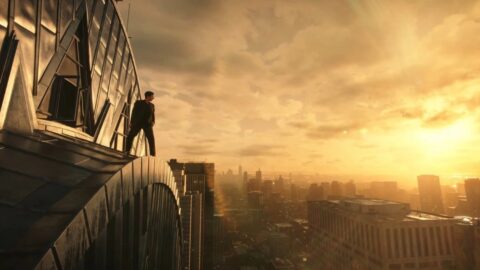It’s hard to see Megalopolis (2024) as the long-gestating masterpiece that lives up to all of its hype. But it’s even harder not to be in awe of what’s put on display (and on stage) by 85-year-old film legend Francis Ford Coppola.
His self-funded opus with a 120-million-dollar price tag never seems to exhaust itself with new ideas — visually, thematically, philosophically. It’s a daring work that, without announcement, breaks the fourth wall in a baffling instance of live performance cinema, only to dive even deeper into its zany allegory that transposes New York City to the fictional metropole of New Rome.
Recalling the inevitable fall of the historical Rome, the auteur of American masterpieces like The Godfather (1972), The Conversation (1974) and Apocalypse Now (1979) is stating the obvious here: we too live in the vestiges of a crumbling empire. And if that centre can’t hold, what responsibility do we in the present have towards the future?
Time is of the essence. Especially for Adam Driver as Caesar Catalina, a visionary architect who has burdened himself with the seemingly impossible task of redesigning New Rome into the utopia of tomorrow. His designs involve a highly malleable new material called Megalon, functioning as a connecting tissue between the dead and the living, almost becoming a physical manifestation of time. It’s unexplained why Caeser can also stop time, but the film makes a fascinating point that controlling time is what artists always do when they compose a painting, write a poem, craft a film or stage a play. They create a new world and thus are masters of its chronology.
Megalopolis’ restless overture sees Caeser at the top of the Chrysler Building, overlooking a highly tampered-with, yet still recognisable New York, where yellowish clouds feverishly race past the skyline and an artificial sun pierces the screen. This is the world he wants to control and reshape in his grand utopian vision. The whole thing feels like the 21st-century answer to Fritz Lang’s 1927 epic Metropolis, the urtext of intellectual science-fiction on the intersection of technology and class struggle. And just like Lang, Coppola transforms his allegorical city into a political stage where the elite feuds over society’s destiny.
Ceasar’s rivalry with a colourful cast of characters — salacious bankers, corrupt politicians and power-hungry media personalities — mostly recalls Shakespeare. Appropriately, Driver suddenly breaks out into Hamlet’s iconic soliloquy, to posit Caeser as the lone dreamer trapped in a snake pit of corruption and greed. This theatrical approach to cinema is Coppola’s MO, drawing heavily stylised, occasionally clunky, but ultimately endearing performances out of an incredible ensemble cast, including Aubrey Plaza, Dustin Hoffman, Jon Voight, Shia LaBeouf and Laurence Fishburne.
Most notably, Coppola’s fable on the folly of men is one of the more intriguing examples of how one can put green-screened CGI technology to specific use. It’s rare to witness a director thinking through the infrastructure of a studio film in real time, messing around with the visual potential of the medium in a way that recalls the inventive days of early silent film. It’s like seeing glimmers of Abel Gance’s brilliance refracted in the technological fetishism of James Cameron. Some shots, especially the more surreal and painterly ones, are painfully poignant, inspiring a sense of wonder rarely seen in mainstream cinema anymore. In this regard, Megalopolis is easily one of the most significant pieces of digital cinema since George Lucas’ Star Wars: Episode II – Attack of the Clones (2002) — the first major blockbuster propelling film into the digital age.
Much like Caeser Catalina, Francis Ford Coppola’s concerns lie with the future. The utopia in Megapolis isn’t meant to solve all problems, but to inspire a conversation. The same can be said about Coppola’s requiem. In the face of the crippling inertia of the present, Megapolis invites you to think in alternatives: alternative languages of film, different modes of production, new conceptions of the future. If the film itself is occasionally lacking, you could interpret that as an invitation as well — an invitation to pick up Coppola’s thread and expand on his dreams of a world where envelope-pushing art can change the course of time.
Hugo Emmerzael is a Dutch film critic and programmer who bridges experimental film and mainstream cinema.

